外加磁场驱动下硬磁软梁的超弹性模型
IF 4.4
2区 工程技术
Q1 ENGINEERING, MULTIDISCIPLINARY
引用次数: 0
摘要
由于基体材料的超弹性特性,在外加磁场的驱动下,硬磁软梁会表现出大而复杂的变形。为了准确合理地计算这种结构的力学性能,目前的应用需要一种完全基于超弹性力学的理论模型来模拟轴向和弯曲变形。根据有限变形理论,提出了完全基于超弹性材料理论的硬磁软梁模型,得到了其总能量方程。提出了一种求解梁变形的迭代算法,并提出了一种自适应遗传算法来提高求解效率。通过与前人研究结果的对比,验证了模型的有效性。在此基础上,分析了外加磁场驱动下的硬磁软梁的结构响应。定义了一些新的无量纲量来描述结构性能和变形。研究发现,当外加磁场方向角不大于90°时,悬臂端无量纲正切角、悬臂端无量纲正割角和梁两端无量纲距离这三个量纲量均与外加磁场方向角无关。通过研究还可以得出,外磁场方向角越大,光束两端的距离越近,光束悬臂端延伸的距离越小。本文章由计算机程序翻译,如有差异,请以英文原文为准。
Hyperelastic model of hard-magnetic soft beams driven by the external magnetic fields
Due to the hyperelastic behaviors of matrix materials, hard-magnetic soft beams driven by the external magnetic fields will exhibit large and complex deformation. To accurately and reasonably calculate the mechanical properties of this structure, a theoretical model that can simulate both the axial and bending deformation entirely based on the hyperelastic mechanics is needed for current applications. According to the finite deformation theory, a hard-magnetic soft beam model completely based on the hyperelastic material theory is proposed and its total energy equation of the hard-magnetic soft beam can be obtained. An iterative solution algorithm is also proposed to solve the deformation of the beam and an adaptive genetic algorithm is presented to enhance the solution efficiency. By comparing with the previous research results, the validity of the model is verified. On this basis, the structural responses of hard-magnetic soft beams driven by external magnetic fields are analyzed. Some new dimensionless quantities are defined to describe the structural properties and deformation. It is found that when the direction angle of the external magnetic field is not greater than 90°, the three dimensionless quantities: the dimensionless tangent angle of the cantilever end, the dimensionless secant angle of the cantilever end and the dimensionless distance between the two ends of the beam are all independent on the direction angle of the external magnetic field. From the study, it can also be concluded that the greater direction angle of the external magnetic field will result in the closer distance between the two ends of the beam and reduce the range extension reached by the cantilever end of the beam.
求助全文
通过发布文献求助,成功后即可免费获取论文全文。
去求助
来源期刊

Applied Mathematical Modelling
数学-工程:综合
CiteScore
9.80
自引率
8.00%
发文量
508
审稿时长
43 days
期刊介绍:
Applied Mathematical Modelling focuses on research related to the mathematical modelling of engineering and environmental processes, manufacturing, and industrial systems. A significant emerging area of research activity involves multiphysics processes, and contributions in this area are particularly encouraged.
This influential publication covers a wide spectrum of subjects including heat transfer, fluid mechanics, CFD, and transport phenomena; solid mechanics and mechanics of metals; electromagnets and MHD; reliability modelling and system optimization; finite volume, finite element, and boundary element procedures; modelling of inventory, industrial, manufacturing and logistics systems for viable decision making; civil engineering systems and structures; mineral and energy resources; relevant software engineering issues associated with CAD and CAE; and materials and metallurgical engineering.
Applied Mathematical Modelling is primarily interested in papers developing increased insights into real-world problems through novel mathematical modelling, novel applications or a combination of these. Papers employing existing numerical techniques must demonstrate sufficient novelty in the solution of practical problems. Papers on fuzzy logic in decision-making or purely financial mathematics are normally not considered. Research on fractional differential equations, bifurcation, and numerical methods needs to include practical examples. Population dynamics must solve realistic scenarios. Papers in the area of logistics and business modelling should demonstrate meaningful managerial insight. Submissions with no real-world application will not be considered.
 求助内容:
求助内容: 应助结果提醒方式:
应助结果提醒方式:


